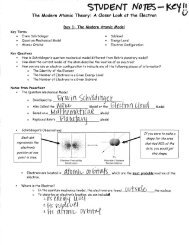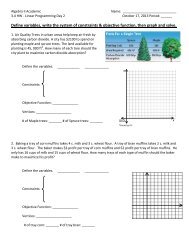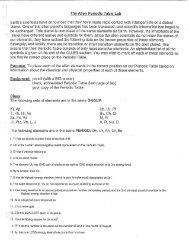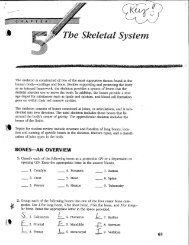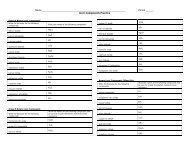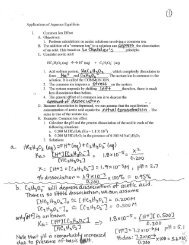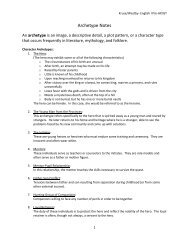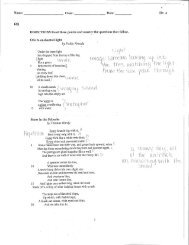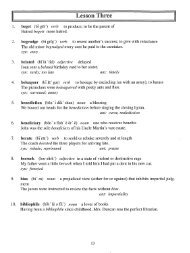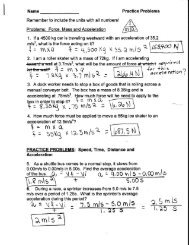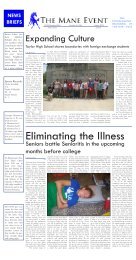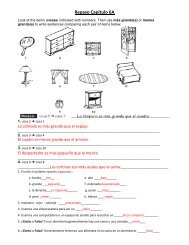Frankenstein Background
Frankenstein Background
Frankenstein Background
You also want an ePaper? Increase the reach of your titles
YUMPU automatically turns print PDFs into web optimized ePapers that Google loves.
or The Modern Prometheus<br />
<strong>Frankenstein</strong><br />
Put your pens down. This is available on the Web.<br />
Listen, discuss, ask questions.<br />
ou are expected to know this, but you don’t need to copy!
Getting Ready to Read<br />
What do you know about <strong>Frankenstein</strong>?<br />
Why is there such controversy over cloning?<br />
What is man’s biggest fear?
Mary Shelley (1797-1851)<br />
Born: Somers Town,<br />
England<br />
Parents: feminist<br />
Mary Wollstonecraft<br />
and philosopher<br />
William Godwin.
Mom had an affair with a military captain<br />
which resulted in her first child,<br />
Fanny. Soldier abandoned them. Mom<br />
attempted suicide. Later met Godwin, had an<br />
affair. Got pregnant again (w/ Mary) and they<br />
married to legitimate both kids<br />
Wollstonecraft dies as the result of Mary's<br />
birth. Mary is then raised by her resentful<br />
father and an evil stepmother
Shelley learned about her mother only through<br />
writings her mother left behind, including A<br />
Vindication of the Rights of Women (1792)<br />
which advocated that women should have the<br />
same educational opportunities as rights in<br />
society as men.<br />
Avid reader and scholar and knew through her<br />
father some of the most important men of the<br />
time (William Wordsworth and Samuel Taylor<br />
Coleridge)
a lot of famous writers traced through their<br />
house-friends of her father (Percy Shelley,<br />
Coleridge, Charles Lamb)<br />
When she was 9, she and her stepsister hid<br />
under a sofa to hear Samuel Taylor Coleridge<br />
recite ―The Rime of the Ancient Mariner‖, a<br />
poem which influenced her when writing<br />
<strong>Frankenstein</strong>
Dad remarries, Mary Jane Clairmont—<br />
mean woman<br />
-Clairmont tried to train Mary in the<br />
―womanly arts‖ but all Mary would do<br />
was read and write<br />
In her young teens Clairmont sends Mary<br />
to live at Ramsgate with a Miss<br />
Petman. While there took some time off<br />
to travel to Scotland with a friend of the<br />
family
-Returned home, a woman. Became close with her<br />
father who she regularly talked Philosophy with.<br />
-While spending time at home Mary is reintroduced<br />
to Percy Bysshe Shelley (a friend/follower of her<br />
father). Percy is married, but they still fall in<br />
love (similar intellects)<br />
-Father is outraged, but Shelley and Mary<br />
eventually run away together with the help of<br />
Fanny (Mary 16, Percy 21)
-Life is tough for Mary & Percy. Short on $-living in<br />
London<br />
-Percy’s wife, Harriet, bares him a belated son<br />
-Percy’s friend falls in love with Mary<br />
-Mary gets pregnant-has a daughter, who dies<br />
-Fanny commits suicide<br />
-Both are able to write and live as they please
On a visit in Switzerland with PBS, Lord<br />
Byron, his mistress and his doctor,<br />
Polidori, she was challenged to write a<br />
―ghost‖ story. She had heard Byron and<br />
Shelley discussing ―the nature of the<br />
principle of life and whether there was any<br />
chance of its ever being discovered.‖ From<br />
this conversation, she had the ―waking<br />
dream‖ which eventually became the novel<br />
<strong>Frankenstein</strong>.
<strong>Frankenstein</strong> is the only story of the four that was<br />
ever published as a novel.<br />
Polidori wrote "The Vampyre," which is<br />
considered the first modern vampire story. The<br />
story was first published in the April 1819 issue<br />
of New Monthly Magazine, mistakenly under the<br />
name of Lord Byron.
In November, Harriet drowns herself: Percy<br />
and Mary marry in December 1816.<br />
Young Mary Shelley, at age 17, miscarried<br />
her first baby. She later wrote in a letter to<br />
friend Leigh Hunt.... "I dreamt that my little<br />
baby came to life again...that it had only been<br />
cold, and that we rubbed it before the fire, and<br />
it lived. Awake and find no baby. I think<br />
about the little thing all day. Not in good<br />
spirits."
The last years of married life are filled<br />
with disaster for Mary. Her half sister<br />
dies as does another of her children.<br />
Mary becomes depressed, a tendency<br />
she probably inherited from her<br />
mother. She is only partly relieved by<br />
the birth of Percy, their only surviving<br />
child.
Mary and Percy eventually move to<br />
Italy where Percy drowns during a<br />
sailing trip in 1822. Mary is<br />
determined to keep the memory of her<br />
late husband alive. She publishes<br />
several editions of Percy's writings<br />
and adds notes and prefaces to them.
Lord Byron found Percy's body washed<br />
up on the shore of an Italian beach. Due to<br />
plague restrictions, the body must be<br />
burned on the beach. Percy's heart,<br />
however, refused to burn. Byron gave<br />
Mary the heart, and she kept it wrapped<br />
up in a copy of a poem Percy had written<br />
upon the death of his friend, John Keats.
Mary continued to write her own<br />
novels, the most famous one being<br />
The Last Man (1826). This book deals<br />
with human isolation just as her earlier<br />
novel <strong>Frankenstein</strong> did. She writes<br />
numerous short stories and contributes<br />
biographical and critical studies to the<br />
Cabinet Cyclopædia.
The last years of her life were spent in the<br />
company of her son and two good friends.<br />
She tried very hard to free herself from<br />
the strains put on her by being the<br />
daughter and wife of such well-known<br />
people.<br />
Mary Shelley died in 1851 at the age of<br />
fifty-three of a brain tumor.
Historical Context<br />
Ambiguous Walton’s letters dated ―17-‖ with no<br />
reference to anything specific to pinpoint the date.<br />
It is set in the latter part of the 18 th century, at the<br />
end of the Enlightenment and the beginning of the<br />
Romantic period.<br />
It critiques the excesses of the Enlightenment and<br />
introduces the beliefs of the Romantics.<br />
Reflects a shift in social and political thought – from<br />
humans as creatures who use science and reason to<br />
shape and control their destiny to humans as<br />
creatures who rely on their emotions to determine<br />
what is right.
Ideas of the Enlightenment<br />
Scientific observation of the outer world<br />
Logic and reason; science and technology<br />
Believed in following standards and traditions<br />
Appreciated elegance and refinement<br />
Interested in maintaining the aristocracy<br />
Sought to follow and validate authority<br />
Favored a social hierarchy<br />
Nature should be controlled by humans
Important Revolutions<br />
American and French Revolution (call for<br />
individual freedom and an overthrow of<br />
rigid social hierarchy)<br />
Industrial Revolution – social system<br />
challenged by change from agricultural<br />
society to industrial one with a large,<br />
impoverished and restless working class
Romanticism<br />
Definition:<br />
A movement of the eighteenth and<br />
nineteenth centuries that marked the<br />
reaction in literature, philosophy, art,<br />
religion, and politics to the formalism of<br />
the preceding (Neoclassic) period.<br />
The Neoclassic period valued reason,<br />
formal rules, and demanded order in<br />
beauty.
Visual Arts: Examples<br />
Neoclassical Art<br />
Romantic Art
Characteristics of Romantic Period<br />
Emphasis on imagination and emotion, individual<br />
passion and inspiration<br />
Rejection of formal, upper class works and a<br />
preference for writing (poetry) that addresses<br />
personal experiences and emotions in simple,<br />
language<br />
A turn to the past or an inner dream world that is<br />
thought to be more picturesque and magical than<br />
the current world (industrial age)
Characteristics of Romantic Period<br />
Belief in individual liberty; rebellious<br />
attitude against tyranny<br />
Fascination with nature; perception of<br />
nature as transformative
Characteristics of Romantic Period<br />
Concerned with common people<br />
Favored democracy<br />
Desired radical change<br />
Nature should be untamed
Romanticism<br />
Characteristics:<br />
The predominance of imagination over reason<br />
and formal rules<br />
Primitivism<br />
Love of nature<br />
An interest in the past<br />
Mysticism
Individualism<br />
Idealization of rural life<br />
Enthusiasm for the wild, irregular, or<br />
grotesque in nature<br />
Enthusiasm for the uncivilized or ―natural‖<br />
Interest in human rights<br />
Sentimentality<br />
Melancholy<br />
Interest in the gothic
Supernatural And Gothic<br />
Literary Themes<br />
Supernatural motifs appear throughout<br />
literature but are most prominent in the<br />
literary genre labeled "Gothic," which<br />
developed in the late eighteenth-century and<br />
is devoted primarily to stories of horror, the<br />
fantastic, and the "darker" supernatural<br />
forces. The English Gothic novel originated<br />
with the publication of Horace Walpole’s<br />
The Castle of Otranto (1765), which<br />
Walpole called a "Gothic story." <strong>Frankenstein</strong><br />
belongs specifically to the Gothic genre.
Like Gothic architecture, Gothic literature focuses<br />
on humanity’s fascination with the grotesque, the<br />
unknown, and the frightening, inexplicable<br />
aspects of the universe and the human soul. The<br />
Gothic "relates the individual to the infinite<br />
universe" (Varma 16) and creates horror by<br />
portraying human individuals in confrontation<br />
with the overwhelming, mysterious, terrifying<br />
forces found in the cosmos and within themselves.<br />
Gothic literature pictures the human condition as<br />
an ambiguous mixture of good and evil powers<br />
that cannot be understood completely by human<br />
reason.
Thus, the Gothic perspective conceives of<br />
the human condition as a paradox, a<br />
dilemma of duality—humans are divided in<br />
the conflict between opposing forces in the<br />
world and in themselves.<br />
The Gothic themes of human nature’s<br />
depravity, the struggle between good and<br />
evil in the human soul, and the existence of<br />
unexplainable elements in humanity and<br />
the cosmos, are prominent themes in<br />
<strong>Frankenstein</strong>.
Style: Gothic Novel<br />
<strong>Frankenstein</strong> is generally categorized as a Gothic<br />
novel, a genre of fiction that uses gloomy settings<br />
and supernatural events to create and atmosphere<br />
of mystery and terror.<br />
Shelley adds to her development of the plot the<br />
use of psychological realism, delving into the<br />
psyches of the characters in an attempt to explain<br />
why they react as they do and what drives them to<br />
make their decisions.
Supernatural/Gothic<br />
Literary Motifs<br />
A motif is a repeated<br />
theme, image, or literary<br />
device. Look for these<br />
common<br />
supernatural/Gothic motifs<br />
in <strong>Frankenstein</strong>.
The Double or Doppelganger (German for "double-goer"):<br />
Defined by Federick S. Frank as "a second self or alternate<br />
identity, sometimes, but not always, a physical twin. The<br />
Doppelganger in demonic form can be a reciprocal or lower<br />
bestial self or a Mr. Hyde. Gothic doppelgangers often haunt<br />
and threaten the rational psyche of the victim to whom they<br />
become attached" (435).
The double motif involves a<br />
comparison or contrast between<br />
two characters or sets of<br />
characters within a work to<br />
represent opposing forces in<br />
human nature.<br />
The double motif suggests that<br />
humans are burdened with a<br />
dual nature, a soul forever<br />
divided.<br />
Double characters are often<br />
paired in common relationships,<br />
such as twins, siblings,<br />
husband/wife, parent/child,<br />
hero/villain, creator/creature,<br />
etc.
Forbidden Knowledge or Power/ Faust Motif:
Forbidden Knowledge or Power/ Faust Motif:<br />
Forbidden knowledge/power is often the Gothic<br />
protagonist’s goal. The Gothic "hero" questions the<br />
universe’s ambiguous nature and tries to<br />
comprehend and control those supernatural powers<br />
that mortals cannot understand. He tries to overcome<br />
human limitations and make himself into a "god."<br />
This ambition usually leads to the hero’s "fall" or<br />
destruction; however, Gothic tales of ambition<br />
sometimes paradoxically evoke our<br />
admiration because they picture<br />
individuals with the courage to defy<br />
fate and cosmic forces in an attempt<br />
to transcend the mundane to the<br />
eternal and sublime.
Monster/Satanic Hero/Fallen Man:<br />
The courageous search for forbidden<br />
knowledge or power always leads the<br />
hero to a fall, a corruption, or destruc-<br />
tion, such as Satan’s or Adam’s fall.<br />
Consequently, the hero in Gothic<br />
literature is often a "villain." The<br />
hero is isolated from others by his<br />
fall and either becomes a monster<br />
or confronts a monster who is his double. He becomes a<br />
"Satanic hero" if, like Satan, he has courageously defied<br />
the rules of God’s universe and has tried to transform<br />
himself into a god. Note: the mad scientist, who tries to<br />
transcend human limitations through science, is a type of<br />
Satanic hero that is popular in Gothic literature<br />
(examples include Dr. Jekyll and <strong>Frankenstein</strong>).
Multiple Narrative/Spiral Narrative<br />
Method:<br />
The story is frequently told through a<br />
series of secret manuscripts or<br />
multiple tales, each revealing a deeper<br />
secret, so the narrative gradually<br />
spirals inward toward the hidden truth.<br />
The narrator is often a first-person<br />
narrator compelled to tell the story to a<br />
fascinated or captive listener<br />
(representing the captivating power<br />
of forbidden knowledge). By<br />
revealing to us their own souls’<br />
secrets, these narrators reveal the<br />
secrets of humankind’s soul.
Dreams/Visions:<br />
Terrible truths are often revealed to characters through<br />
dreams or visions. The hidden knowledge of the<br />
universe and of human nature emerges through dreams<br />
because, when the person sleeps, reason sleeps, and<br />
the supernatural, unreasonable world can break<br />
through. Dreams in<br />
Gothic literature<br />
express the dark,<br />
unconscious depths of<br />
the psyche that are<br />
repressed by reason—<br />
truths that are too<br />
terrible to be<br />
comprehended by the<br />
conscious mind.
Signs/Omens:<br />
Reveal the<br />
intervention of<br />
cosmic forces and<br />
often represent<br />
psychological or<br />
spiritual conflict<br />
(e.g., flashes of<br />
lightning and violent<br />
storms might<br />
parallel some<br />
turmoil within a<br />
character’s mind).
The Novel<br />
This epistolary novel begins with letters written from<br />
Robert Walton to his sister. The point of these letters<br />
is to set up the pretense that this is a true story. This<br />
is a very popular technique at the time this novel was<br />
written.<br />
In the letters, the story of Captain Walton unfolds.<br />
Eventually winding up in the Arctic circle and picks<br />
up Victor <strong>Frankenstein</strong> who relates his story to<br />
Captain Walton. The main part of the novel is this<br />
story, now no longer in letter form, but as Victor<br />
relates it.
Structure and Point of View<br />
Frame Story<br />
Epistolary – carried by letters
<strong>Frankenstein</strong><br />
She did not put her name on the novel<br />
when it was published in 1818.<br />
Many assumed it had been<br />
written by her husband.<br />
She attached her name to the<br />
novel in the 1831 edition.
. . . or a Modern Prometheus<br />
The complete title of this book is<br />
<strong>Frankenstein</strong> or a Modern Prometheus.<br />
Byron, who was with Shelley when she<br />
began to write this novel, wrote a poem<br />
titled "Prometheus" that she would have<br />
been familiar with and inspired by<br />
The story of Prometheus goes as follows:
Prometheus was one of the titans that sided with Zeus and<br />
the gods against Cronus and the titans. Later, after the gods<br />
ruled and mankind was created, Prometheus desired to give<br />
mankind a gift of fire. Zeus forbade it since man would<br />
misuse it to make weapons and such and since if man had<br />
fire, they would not be as reliant on the gods. Prometheus<br />
stole some from Mt. Olympus and gave it to man. As a<br />
result, man was punished by Zeus giving them woman<br />
(horrors upon horrors!) and Prometheus was chained to a<br />
rock where an eagle (or vulture in some myths) eats his<br />
liver out everyday. Since he is immortal, it grows back<br />
only to be eaten again the next day. Hercules later rescued<br />
Prometheus (but nobody rescued man!).
Just as Prometheus went too far to<br />
give mankind the mysteries of the<br />
gods, Victor goes too far in<br />
discovering the mysteries of God by<br />
trying to defy death and learn how to<br />
create life.
Major Characters<br />
Victor <strong>Frankenstein</strong> – protagonist, product<br />
of an idealistic Enlightenment education;<br />
fueled by possibilities of science and a<br />
desire for acclaim; becomes obsessed with<br />
creating life from spare body parts.<br />
Rational demeanor dissolves and by story’s<br />
end, consumed by primitive emotions of<br />
fear and hatred.
Major Characters<br />
The Creature - never named; is Victor’s<br />
doppelganger (alter ego); Creature<br />
rationally analyzes the society that rejects<br />
him; sympathetic character, admires people<br />
and wants to be a part of human society;<br />
only results in violence when he is<br />
repeatedly rejected
The Legend of the Golem<br />
The monster in <strong>Frankenstein</strong> is a flesh golem.<br />
Definition of a golem:<br />
The word golem is used in the Bible to refer to<br />
an embryonic or incomplete substance: Psalm<br />
139:16 uses the word "gal'mi", meaning "my<br />
unshaped form. Similarly, Golems are used<br />
today primarily in metaphor either as brainless<br />
lunks or as entities serving man under controlled<br />
conditions but enemies in others. Similarly, it is a<br />
Yiddish slang insult for someone who is clumsy<br />
or slow.
Having a golem servant was seen as<br />
the ultimate symbol of wisdom and<br />
holiness, and there are many tales of<br />
golems connected to prominent rabbis<br />
throughout the Middle Ages
The existence of a golem is in most<br />
stories portrayed as a mixed blessing.<br />
Although not overly intelligent, a golem<br />
can be made to perform simple tasks over<br />
and over. The problem is one of control or<br />
getting it to stop, bearing a resemblance to<br />
the story of the broomstick in The<br />
Sorcerer's Apprentice.
Major Characters<br />
Henry Clerval – Victor’s childhood friend; true<br />
romantic, wants to leave mark on the world, but<br />
never loses sight of ―the moral relations of things<br />
Elizabeth – adopted as an infant by Victor’s<br />
family; marries Victor<br />
Robert Walton – Arctic explorer who’s obsessed<br />
with gaining knowledge and fame; rescues Victor<br />
in the Arctic; through letters to his sister, Mrs.<br />
Margaret Saville, he relates how he met<br />
<strong>Frankenstein</strong> and the fantastic story <strong>Frankenstein</strong><br />
tells him
Characters in <strong>Frankenstein</strong> (Secondary Characters)<br />
Justine Moritz. Justine is employed in the<br />
<strong>Frankenstein</strong> hosehold. She cares for the dying Mrs.<br />
<strong>Frankenstein</strong> and is greatly loved by the family.<br />
Agatha, Felix, and Mr. De Lacey. Mr. De Lacey is the<br />
blind father of Agatha and Felix, the young people<br />
who live in the cottage near the place where the<br />
monster hides.<br />
Safie. Safie is a young Turkish or Arabian woman<br />
who flees her father to marry Felix.
Characters in <strong>Frankenstein</strong> (Minor Characters)<br />
Mrs. Margaret Saville. Walton’s married sister, Mrs.<br />
Saville, is the specified audience of the story.<br />
Alphonso <strong>Frankenstein</strong>. Victor’s father, Alphonso,<br />
unkonwingly encourages his son;s studies b a passing<br />
remark. Alphonso worries about Victor when their<br />
correspondence is infrequent.<br />
Ernest <strong>Frankenstein</strong>. Victor’s younger brother does<br />
not share Victor’s passion for scientific study.<br />
William <strong>Frankenstein</strong>. William is the youngest of the<br />
<strong>Frankenstein</strong> children.
Characters in <strong>Frankenstein</strong> (Minor Characters)<br />
Caroline Beaufort <strong>Frankenstein</strong>. The daughter of<br />
Alphonso’s good friend, Caroline marries Alphonso after<br />
her father’s death. Mindful of her own poverty-stricken<br />
past, she adopts Elizabeth Lavenza from the poor family<br />
who has been raising her.<br />
Professors Krempe and Waldman. These two scholars<br />
influence <strong>Frankenstein</strong>’s work at the university at Ingolstadt.<br />
Mr. Kirwin. He is the magistrate in the village in Ireland<br />
where <strong>Frankenstein</strong> is accused of murder.<br />
Daniel Nugent. He is one of the witnesses against<br />
<strong>Frankenstein</strong>.
Alchemy<br />
Medieval ―science‖ and philosophy<br />
Convert base metals into gold<br />
Seen as a universal cure for disease<br />
Means of prolonging life
Cornelius Agrippa<br />
September 14th, 1486 - February 18th, 1535<br />
Agrippa was the scientist Victor studied before the<br />
university. This was his first introduction into<br />
science. Just who was this man?<br />
He was:<br />
*a magician *soldier<br />
*occult writer *astrologer<br />
*alchemist *legal expert<br />
*early feminist *physician<br />
*theologian<br />
Where have you heard his name?
Themes<br />
Consequences of irresponsibility in the<br />
pursuit of knowledge<br />
Consequences of pride<br />
Consequences of society’s rejection of<br />
someone who is unattractive<br />
Destructive power of revenge<br />
Motifs<br />
Parent-child conflicts<br />
Sympathy
Themes<br />
1. Ignorance is Bliss - The quote at<br />
the beginning from chapter four<br />
illustrates this perfectly. This theme is<br />
a warning to avoid going too far with<br />
science. There are some mysteries that<br />
mankind was not meant to understand.
2. Human Injustice Toward Outsiders<br />
- The monster is an outsider to all<br />
humankind. The old blind man is an<br />
outsider because of his age and<br />
blindness. Justine is an outsider because<br />
of her being adopted. Victor is an<br />
outsider because he alone has the<br />
knowledge of what he has done and the<br />
existence of the monster.
3. The Treatment of Women - Victor<br />
doesn't mistreat women, but he does<br />
portray an 1800s view of male<br />
superiority. The monster, on the other<br />
hand, does not have the upbringing like<br />
Victor's, therefore, his idea of the<br />
equality of women is different.
4. Nature vs. the Unnatural - With the<br />
industrial revolution taking place, many<br />
Victorian novels expressed fear and<br />
distrust of the newer technology and<br />
leaps in science. This book expresses<br />
those fears through several scenes.
Other Literary Elements<br />
Irony – 2 major ironies<br />
Creature is more sympathetic, more<br />
imaginative and more responsible to fellow<br />
creatures<br />
Creature has many pleasing qualities but is<br />
an outcast because he’s not physically<br />
attractive
Symbols<br />
White/light= knowledge<br />
Water = knowledge<br />
Ice = danger<br />
Lightning = nature’s power<br />
Nature = acceptance, nuturing, calm<br />
Mountains= sublime in nature
Antithesis<br />
Contrasts of ideas, characters, themes, settings or<br />
moods<br />
Victor/creation<br />
Passion/reason<br />
Natural/unnatural<br />
Known/unknown<br />
Civilized/savage<br />
Masculine/feminine<br />
Beautiful/ugly<br />
Good/bad<br />
Light/dark<br />
Heat/cold
Allusion<br />
2 poems are alluded to in the novel:<br />
Paradise Lost by John Milton – story of<br />
man’s fall from innocence to painful<br />
knowledge; Victor can be compared to<br />
Adam, Satan, and Eve<br />
The Rime of the Ancient Mariner by<br />
Samuel Taylor Coleridge, like narrator,<br />
tells story as a warning and a confession
Literary Allusions<br />
Volney's Ruins of Empires:<br />
This is the book that Felix uses to<br />
instruct Safie. While doing so, the<br />
monster learns world history. The book<br />
has a future prediction in it that all<br />
religions will eventually become one<br />
after mankind realizes the single truth<br />
that they all share.
Literary Allusion 2<br />
Johann Wolfgang von Geothe's Sorrows<br />
Werther:<br />
This was one of the books the monster found in a<br />
satchel while out in the woods that the monster<br />
reads to learn more about mankind. Young men<br />
began to dress like the character and there was<br />
even the first reported cases of copycat suicides<br />
as young men tried to imitate the suicide of<br />
young Werther. Werther was in love with a<br />
woman who was engaged and could not love him<br />
back.
Literary Allusion 3<br />
Plutarch's Parallel Lives:<br />
Another book found in the satchel. This<br />
one gives history through the lives of<br />
Greek and Roman heroes. None of these<br />
heroes are female, but this is one of the<br />
best sources for information on the life<br />
of women in the ancient world.
Literary Allusion 4<br />
John Milton's Paradise Lost:<br />
Much more popular than its sequel, Paradise<br />
Regained, this epic is about the fall of Satan<br />
and the subsequent fall of man. In it, Satan<br />
has cool quotes like, "Better to reign in hell<br />
than to serve in heaven." This book was also<br />
found in the satchel.<br />
More about this book:
Did I request thee, Maker, from my clay<br />
To mould me man? Did I solicit thee<br />
From darkness to promote me?<br />
John Milton's Paradise Lost &<br />
the beginning of the 1818 version of<br />
<strong>Frankenstein</strong>
Monster vs. Adam<br />
The monster reads a copy of Paradise Lost,<br />
which stirs him. The monster compares his<br />
situation to that of Adam. Unlike the first man<br />
who had "come forth from the hands of God a<br />
perfect creature," <strong>Frankenstein</strong>'s creature is<br />
hideously formed. Unlike Adam, the monster<br />
is abandoned by Victor <strong>Frankenstein</strong> and finds<br />
himself "wretched, helpless, and alone."
Monster vs. Satan<br />
The monster can also be compared to<br />
Satan since both were created to be<br />
beautiful and neither directly attacks<br />
their creator, but rather, the ones most<br />
dear to their creator.
Victor vs. Adam/Satan<br />
Victor can be compared to Adam since<br />
both achieved their downfall via<br />
searching for knowledge that they should<br />
not have.<br />
In Paradise Lost Satan's sin is pride.<br />
Victor is motivated by his pride to be the<br />
best and to hide his actions, even to the<br />
expense of Justine's death.
The Unreliable Narrator<br />
Just as in Percy's "Ozymandius" and Emily Bronte's<br />
Wuthering Heights, Mary Shelley's <strong>Frankenstein</strong> has<br />
an inside/outside narrator. The whole story is Robert<br />
Walton's retelling of what Victor tells him. In some<br />
cases the monster is telling Victor who is in turn<br />
retelling it to Walton who in turn retells it to us. Now<br />
we have no reason to really doubt Walton. We can,<br />
however, build a case to scrutinize what Victor is<br />
telling. We can also analyze the truthfulness of the<br />
monster's story. Did the monster really try to save<br />
the girl from drowning, or is he lying in order to<br />
make himself look better?
An unreliable narrator cannot be fully<br />
trusted either because they do not<br />
understand what they are narrating (as in<br />
Flowers for Algernon and The Adventures<br />
of Huckleberry Finn) or they may simply<br />
be lying to the reader to suit their needs.<br />
Many people question the story of the<br />
monster (and for that matter, Van Helsing<br />
in Dracula).
Surveying the Text<br />
How is the text organized?<br />
How long is each chapter?<br />
What did the publishers and author include<br />
before the actual novel? After the end of the<br />
novel?



